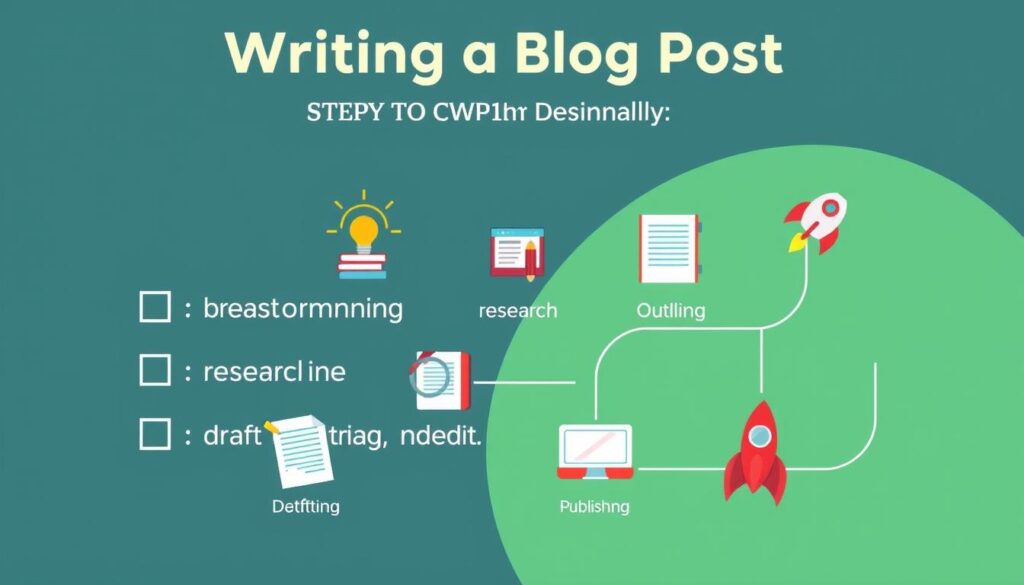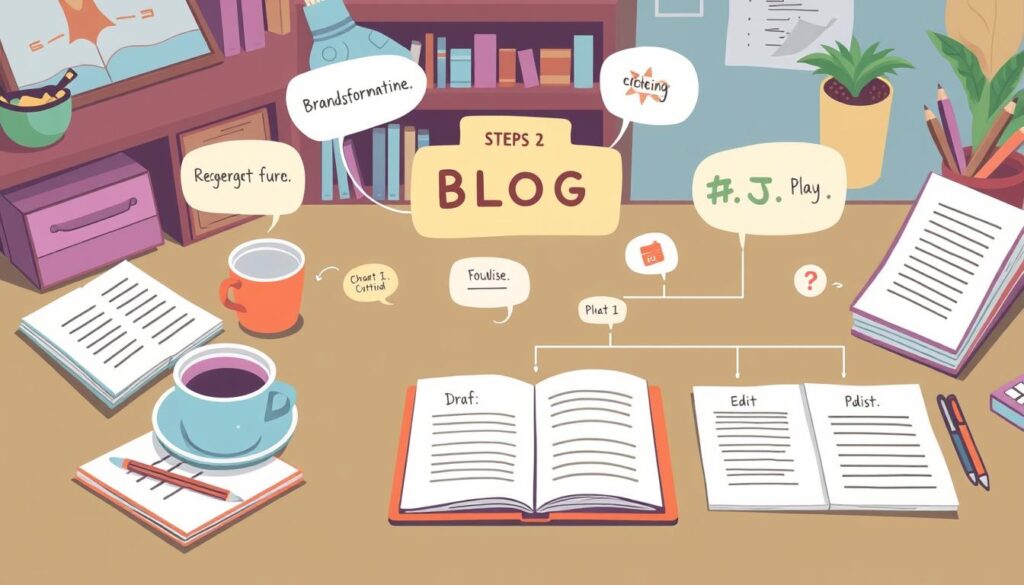Starting a blog is exciting but can also feel overwhelming. It’s key to know your audience and create content they’ll love. Writing well means balancing value, smart keyword use, and real engagement. Your first posts set the stage for your blog’s identity and help you stand out.
Key Takeaways
- Blogs with images receive 94% more views, enhancing your post’s engagement.
- SEO is crucial for blogging, accounting for 53% of website traffic.
- Engage your audience with concise and captivating content in the initial paragraphs.
- Include authoritative links to increase trust; 60% of users trust blogs citing credible sources.
- Editing is vital; 80% of users will ignore posts with spelling or grammatical errors.
Understanding Your Audience
Creating a successful blog post requires knowing your audience well. It’s about understanding their needs, likes, and what they expect to find. This knowledge lets you make content just right for them.
Identify Their Pain Points
It’s key to know what challenges your readers have. Your content should aim to solve these problems or provide new insights. Tools like SEMrush, Moz, or Google Keyword Planner help find these issues. By tackling these, your blog post can truly resonate with your readers.
Research Audience Interests
Understanding what interests your audience is crucial. Use social media, forums, and surveys to learn about them. This helps you write about topics they really care about. Blogs that post often are more likely to get a lot of traffic, underlining the need for engaging content.
Choosing Your Blog Post Topic
Choosing the right blog topic is vital, as many first-time bloggers doubt their first content choice. To help, it’s key to know a few steps to writing a blog post. This can pull in followers and keep them interested.
Brainstorming Ideas
Brainstorming is a key part of the blog writing process. Start by jotting down ideas that match your blog’s focus. Blogging on current topics rather than personal stories boosts engagement by 50%. Feedback from online forums shows 65% of readers prefer thorough guides. Make a list of hot topics, common questions, and big issues. Titles with numbers can bump up clicks by 36%.

Using Keyword Research Tools
Keyword research tools greatly help in writing for SEO. They show what people are searching for. This guides your blog topic choices. About 80% of blog visits come from specific, longer phrases. This boosts your site’s visibility and organic traffic. Using the right keywords in your content also helps improve your SEO rank. It could increase your traffic by half. With these tools, find and write about topics people don’t cover much but are searching for a lot.
Choosing topics wisely and using the right tools can make your blog popular. 70% of bloggers say picking the right topic is key to drawing in readers. Stick to 2-3 main topics for better interaction and quicker growth.
Crafting an Engaging Headline
When writing a blog, the headline is super important. About 70% of bloggers think their headlines are key to grabbing attention. In a world full of content, your headline must stand out and make readers want to click.
Importance of a Catchy Title
A great title can make or break your blog post. Posts with numbered headlines like “5 Tips” get 36% more attention. Adding strong adjectives can increase clicks by 15%. Emotional headlines also boost engagement by the same amount.
Research by BuzzSumo found that the best headlines have about 12 words. Testing shows headlines with 6 to 13 words are just right. They’re clear but not too wordy. Plus, catchy titles get shared 2 to 3 times more on social media.
SEO-friendly headlines with the right keywords can get 50% more clicks. Also, personal touches in headlines can attract 20-30% more clicks. This shows how customizing your title can make a big difference.
“80% of readers don’t make it past the headline, so make your first impression count.”
As you work on your blog writing, keep in mind the power of a strong headline. Using tools to analyze your headline can help. They show you the best emotional and power words to use. This makes sure your blog post stands out from the start.
Structuring Your Blog Post
Writing a blog post means paying attention to its structure. This lets you grab readers’ attention and improves SEO. By breaking down the content into clear parts, you make it easier to follow. We’ll cover what makes a good blog structure.
Introduction
The introduction is key to getting readers hooked right away. It introduces the topic and sets the tone. A strong start can make readers stick around. Use a surprising fact or a story they can relate to, to capture their interest.

Body
In the body, you dive into your main ideas. Clear headings and subheadings are needed to make it readable. This is because most people like to scan content online. Also, adding examples or evidence keeps it interesting. Keep paragraphs short for better engagement.
- Ensure logical flow between sections.
- Use transition words to enhance content flow and comprehension.
- Incorporate visuals like images or infographics to break up text and emphasize key points.
Writing an Engaging Introduction
It’s key to grab the reader’s interest from the start. This is vital in a world with over 600 million blogs. Starting with a personal story can make your blog stand out. It helps create a connection with your readers.
Personal Anecdote or Story
Everyone enjoys a good tale. Kicking off with a personal story makes your blog seem more real and touching. For example, sharing a moment that’s tied to your blog’s topic can immediately catch your readers. Imagine opening your blog by recounting a time you realized something big:
“I remember the moment I decided to start my blog. It was during a rainy afternoon, over a cup of coffee, when I stumbled across an article that ignited a spark within me. I realized I had a lot to share and that I could help others through my engaging blog posts.”
This way of starting adds a personal touch and promises valuable content. It makes the reader feel connected from the beginning.

Presenting a Problem or Question
Another way to hook readers is by presenting a problem or question. It gets readers curious. For instance, asking a relevant question or describing a common problem can engage readers. They’ll want to keep reading for solutions:
“Have you ever spent hours crafting a blog post only to see minimal engagement? You’re not alone. Statistics show that 70% of readers don’t read past the introduction of a blog post. So, how can you ensure your blog content creation captures attention right from the get-go?”
Introducing a relatable issue or an intriguing question invites readers in. They likely want answers. This method makes your posts more appealing and informative from the start.
Developing the Main Content
Developing your blog’s main content means offering valuable, specific details. Readers do a lot of research online before making choices. So, giving them complete information is key. This not only builds trust but also adds value to your blog.

Providing Detailed Information
To make your blog posts stand out, look deeply into your topic. Well-researched content gives readers valuable insights. It answers their important questions. This builds trust and loyalty.
For example, if you’re writing about blogging tactics, cover every aspect clearly. But, make sure not to overwhelm your readers.
Use of Examples and Case Studies
Adding real-life examples and case studies boosts your blog’s credibility. They make your posts more relatable and practical. Case studies show how theories work in the real world.
This approach makes your blog not just informative but also engaging. Remember, including stories in your blogging tactics often deeply connects with your readers.
Focusing on these methods helps your blog draw in organic traffic. It becomes a “prospect magnet,” reducing the need for paid ads. Consistency and high-quality content lead to ongoing interest and trust from your audience.
How to Write Your First Blog Post
Starting your journey as a new blogger is exciting and challenging. We’ll guide you through making your first blog post. This will help you move smoothly through the process and dodge common mistakes.
Step-by-Step Process
Writing a great blog post involves several key stages. First, figure out who your readers are and what they need help with. Then, think of topics they’ll be interested in. Use keyword research tools to find phrases that make your post easy to find online. These steps help create a blog post that grabs attention:
- Choose your topic: Pick a topic that will draw in a specific group of readers.
- Craft an engaging headline: Make a headline that gets readers excited.
- Write a compelling introduction: Begin with a story or a problem to catch interest.
- Develop the main content: Give a lot of details and use examples or studies to make things clear.
- Include visual elements:

- Optimize for SEO: Use keywords in a natural way, write a meta description, and choose the right alt text.
- Edit and proofread: Make sure your post has no grammar errors and reads well.
Common Mistakes to Avoid
Some errors can lower the quality of your blog post. Here are mistakes new bloggers should avoid:
- Overstuffing keywords: It’s important to use keywords, but too many can ruin your content and harm your search rankings.
- Neglecting proofreading: Always double-check your work to fix mistakes and improve your credibility.
- Ignoring audience insight: Not meeting your audience’s needs can lead to less interest and fewer readers.
By sticking to these blog creation steps and avoiding these mistakes, you’re on track to creating a captivating and effective first blog post.
Incorporating Visual Elements
Making your blog engaging is an art. Adding visual parts like images and videos can make a huge difference. Most people check out only 20% of a blog’s text. That means using different visuals is key to keep them interested.

Using Images and Graphics
Adding high-quality pictures and graphics is vital. Studies show folks remember just 10% of what they’ve read after three days. But, if there’s a picture, they recall up to 80% of the info. This fact makes including images every 300 words a smart move to maintain reader interest.
Why images are great:
- They boost engagement and sharing.
- They help readers remember information better.
- They make your blog look better.
Embedding Videos
Videos can keep visitors on your page longer. They change up the text and present info in an exciting way. By adding captions, video views can grow by 7.32%. Videos make your content richer and help your blog rank better in search engines.
Using visual elements wisely can take your blog to the next level. It ensures readers are happy and stay longer on your site. When done right, visuals can turn casual visitors into dedicated fans.
Optimizing Your Blog Post for SEO
When working on blog post SEO optimization, several strategies can really help. These strategies boost your blog’s search engine presence. Let’s dive into some key parts now.
Keyword Placement
Putting keywords in the right spots is crucial. They should fit smoothly into the title, headings, and body of the post. Avoid cramming too many keywords together. Google’s smart algorithms can spot and punish that. Just weave your keywords into your post in a natural, sensible way.
Meta Descriptions and Alt Text
Meta descriptions sum up your blog post. They’re key in pulling in readers from search results. A good meta description can really up your clickthrough rates. A 2024 First Page Sage study found that top spots on the search page get 39.8% of clicks.
Also, adding alt text to images makes your content more accessible. It helps people using screen readers and boosts your SEO. Your alt text should clearly describe the image and include important keywords, like those for writing for blogs.
Finding the right mix of fun content and smart SEO tactics is essential. It’ll help your website do well by attracting more readers and ranking higher on search engines.
Editing and Proofreading
Getting your first draft done is just the start. You must edit and proofread to make your work great. This step removes errors and makes your writing clear and exciting.
Common Grammar Mistakes
When you edit, look out for mistakes that could hurt your blog’s trustworthiness. Watch out for problems like these:
- Subject-verb agreement: Make sure subjects and verbs agree, so your sentences make sense.
- Misplaced modifiers: Place modifiers correctly to avoid confusing your readers.
- Comma splices: Don’t just use a comma to connect two independent clauses. Use a conjunction or semicolon.
- Homophones: Words that sound alike but mean different things can be tricky. Pay attention to “there” and “their.”
Fixing these errors helps make your blog more readable and professional. Using tools like Grammarly or Hemingway can improve your work. They make your writing clear and precise. Remembering these blog writing tips is key to creating good content.

Adding Internal and External Links
Adding links in your blog is key to boosting its value and how often it’s seen. By using advanced blogging techniques and connecting your posts, you can make your readers more engaged. This can also make your blog rank higher in search engine results.

Linking to Your Own Content
Linking your content together is called internal linking. This technique can increase a blog’s search engine ranking significantly. Some studies show a 40% rise in traffic for blogs that do this.
Also, articles with links make readers stay 70% longer because they find more interesting content easily. A good linking strategy helps both people and search engines navigate your blog better. It shows how different posts are related.
Google uses these links to find and rank your content. So, putting links wisely can increase your blog’s authority. This could lead to a 50% rise in visitors in just three months.
Referencing Authoritative Sources
Using external links to credible sources boosts your blog’s trustworthiness. These links act like a thumbs-up for your content, making it seem more accurate. Blogs that link to trustworthy sites can build better relationships with their readers.
When you mention respected sources, you also lead your readers to more useful information. This adds depth to your blog and promotes a sense of community. It shows you’ve done your homework, which might improve your Google rankings.
Both internal and external links are important in advanced blogging techniques. They turn your blog into a trusted, in-depth resource for readers. Integrating these links thoughtfully improves how users experience your site and strengthens your SEO efforts.
Creating a Content Calendar
A well-planned content calendar is key for an effective blog. It keeps your schedule organized and makes sure you post regularly. This is important for keeping your audience interested and attracting more visitors. A content calendar also makes planning easier, leading to better and more efficient work.

Planning Future Blog Posts
Planning your posts is crucial. Set deadlines 2-3 days before you plan to publish. Many marketing teams, about 62%, use tools like Google Sheets for this. Here are some strategies to consider:
- Plan your content monthly or quarterly to keep track of everything.
- Use a five-status system to monitor your progress: In Progress, Written, Edited, Approved, and Published.
- Make your blog diverse by planning at least five types of content.
- Schedule posts for seasonal events. About 75% of content is planned for holidays and fairs.
Good planning can cut down production time by 25%, boosting productivity.
Staying Consistent
Being consistent improves your blog a lot. A planned calendar can boost publishing regularity by over 80%. Blogs with 16 posts a month get 3.5 times more traffic than those with 0-4. Start with a post a week and adjust as needed. Keep your calendar up to date to keep a steady content flow. This leads to more engagement and traffic.
Also, content management tools can make teamwork 42% more efficient. Consistent blogging with these tools can greatly increase your site’s visits and leads. About 76% of creators say a structured calendar results in better content. So, a reliable content calendar is crucial for a strong blogging strategy.
Promoting Your First Blog Post
Spreading the word about your first blog post is key to attracting an audience. Using social media for bloggers is a great way to reach new readers. It helps drum up excitement for your blog.
Learn how to drive traffic to your first blog post with these proven methods.
Using Social Media
Social media is a must-have for promoting blog posts. Share engaging snippets and add pictures to grab attention fast. It’s a fact that posts with images get 94% more views than those without. Also, blogs that use Pinterest well can see a huge boost in traffic.
Adding calls to action (CTAs) can greatly increase clicks. Studies show that CTAs can improve click-through rates by 47%. Talking to your audience helps too. Answer comments and start discussions. Blogs that connect with their readers see more loyalty and engagement.
Engaging with Your Readers
Building a blog community is about more than just sharing posts. It’s about real conversation. Answer comments, ask your readers questions, and use polls for feedback. This makes your readers feel important and gives you insights into what they like.
Posting regularly is crucial. Blogs that update consistently see better engagement, and frequent posting leads to more leads. Keeping your content fresh encourages readers to keep coming back.
Encouraging Reader Interaction
Getting readers to interact is key to a lively blog community. Even though less than 1% regularly comment, you can boost engagement. Asking open-ended questions at the end of posts works well. This makes readers feel important and listened to.
Giveaways and surveys can also increase reader activity. These methods draw people in and get them to participate. For instance, one post got over 130 comments, showing how a single topic can spark interaction. A follow-up post led to another 78 comments, proving ongoing conversation’s importance.
Add interactive features like polls or calls to comment to get more engagement. When readers answer polls, and you share the results, it invites more comments. This approach keeps the comment section active. It gives bloggers valuable feedback and ideas to make their content better.
Related Articles:
- How to Choose the Perfect Blog Niche
Start with a niche that aligns with your passion and goals. - 7 Proven Ways to Increase Blog Traffic for Beginners
Promote your first post with beginner-friendly traffic strategies. - 7 Blogging Mistakes New Bloggers Make and How to Fix Them
Avoid these common mistakes as you write your first post.








